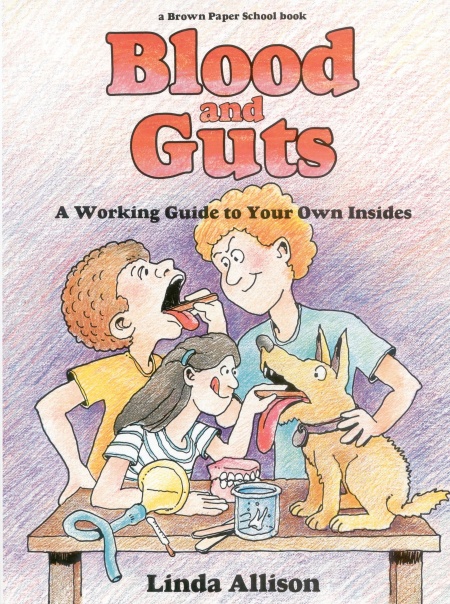Blood and Guts: A Working Guide to Your Own Insides was one of our favorite books for learning about the human body. Even though it was first published in 1976, the cartoonish illustrations still work for today’s audiences. One area where it could be updated is in a very brief chapter on cells. More recent research on cellular microbiology has revealed the amazing factory-like functions within each cell. Also, discoveries about DNA run counter to the comment on page 71 that says, “It’s the vast difference in cell numbers and organization that accounts for the surprising variety of sizes and shapes of living things.” Even so, the book still serves well as an introduction to the systems of the human body and will grab the interest of students.
It covers each of the systems of the human body with both information and activities. Most of the activities are relatively simple. You will still need to plan ahead to obtain supplies like iodine, a magnifying glass, food color, rubbing alcohol, a tennis ball, and raw chicken legs. (A chicken leg is dissected to learn about muscles, and chicken bones are used to learn more about the skeletal system.) A number of activities are integrated throughout most sections of information. This is one of the most hands-on approaches for learning about the human body that I have come across.
You can use the sections on the different body systems in whatever order you wish. For instance, you might want to do the activities in “Skin, the Bag You Live In” on a warm day since some activities have to do with evaporation, or you might want to study the skeletal and muscular systems close together to use the same chicken leg.
Some of the information is presented in bullet points, and other information is in brief paragraphs. The author, Linda Allison, frequently addresses students directly, such as in this paragraph:
Do you ever not brush your teeth for a while? Soon your teeth begin to feel like moss is growing on them. That mossy feeling is caused by plaque (PLAK)” (p. 35).
Unusual vocabulary is presented as in this example with the word italicized and its pronunciation shown in parentheses. The vocabulary words are kept to a minimum, so the book is very readable by students in fourth grade and above. Younger students can listen as someone reads aloud, and they can participate in the activities. Even teens are likely to want to participate in the fun activities.
The author writes based on evolutionary assumptions, so those who disagree might want to skip or discuss with their children some of the author’s comments in that regard.
Summary
Linda Allison wanted to teach science in a way that was attractive to kids and didn’t require specialized equipment. She was very successful, and that’s why this book is still in print.










